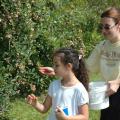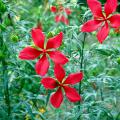News From 2005
MISSISSIPPI STATE -- Patricia R. Knight has been named interim head of the Mississippi State University Coastal Research and Extension Center in Biloxi.
Knight joined the staff of the Mississippi Agricultural and Forestry Experiment Station in 1997 as an assistant horticulturist at the South Mississippi Branch Experiment Station in Poplarville.
By Norman Winter
MSU Horticulturist
Central Mississippi Research & Extension Center
No matter where you go this summer the tropical look is hot, and one of the key ingredients to this Caribbean-style garden is the elephant ear.
With leaves that defy logic in size and proportion to other plants, it's not hard to see why this plant is so loved by Southern gardeners. It is not uncommon to see 6-foot-tall plants with 3-foot leaves on petioles reaching 4 feet.
MISSISSIPPI STATE -- A pet can teach children important life lessons, but parents must decide if their family has the time and devotion to raise one.
Micki Smith, a child and family development agent with the Mississippi State University Extension Service, said parents may be amazed at the qualities children develop from owning a pet.
"Whether it's a fish, bird, dog or cat, pets can help children develop lifelong character traits, such as responsibility, compassion, empathy and the ability to love unconditionally," Smith said.
MISSISSIPPI STATE -- Mississippi's corn may not produce a record yield three-peat in 2005, but many fields still have benefitted from spotty showers in recent weeks.
Much of Mississippi's corn is looking good despite being behind schedule. The areas of the state that haven't received rain since mid-April could prevent the state from posting high average yields. The northwest and north-central parts of the state are extremely dry, and non-irrigated corn there is suffering.
MISSISSIPPI STATE -- Mississippi producers had been using 60-year-old recommendations from Alabama to fertilize ponds in preparation for young catfish, but now are seeing good results with updated recommendations made for local soils.
Fish producers fertilize nursery ponds to stimulate the growth of oxygen-producing algae. These phytoplankton become food for zooplankton, tiny animals that are eaten by catfish fry, or those less than 1 inch long. Fertilizer is used to alter the nutrient content of the water, making it more desirable for this tiny plant and animal life.
By Norman Winter
MSU Horticulturist
Central Mississippi Research & Extension Center
This time of the year, we start heading for the shady part of the garden where it is lush and cool. We think of impatiens, begonias, hostas and caladiums for seasonal color in this area, but there is another plant that needs to be in many more gardens, and that is the crossandra.
MISSISSIPPI STATE -- Mississippi the way it was when European settlers arrived can only be experienced in a few places, and one is the Crosby Arboretum near Picayune.
Just a couple of minutes away from one of south Mississippi's busiest roadways, the arboretum was established in 1980 as a living memorial to timber pioneer and philanthropist L.O. Crosby Jr. It was donated to Mississippi State University by the Crosby Foundation in 1997 and is one of only about 30 public arboretums in the United States.
MISSISSIPPI STATE -- Hurricane Ivan in 2004 served as a wake-up call for many coastal horse owners who drove hundreds of miles to find refuge at the Mississippi Horse Park near Starkville.
The 2005 hurricane season is already validating predictions for another eventful year for Gulf Coast residents still looking at months of risks before the season concludes on Nov. 1.
MISSISSIPPI STATE -- Mississippi's blueberry growers have much to celebrate with an anticipated bumper crop, good prices and high-quality berries.
John Braswell, horticulture specialist with the Mississippi State University Coastal Research and Extension Center in Poplarville, said ideal weather has been the No. 1 contributor to this season's success.
MISSISSIPPI STATE -- Mississippi State University's vice president for the Division of Agriculture, Forestry and Veterinary Medicine is assuming additional duties as interim director of University Extension and Outreach.
Beginning July 1, Vance Watson will provide leadership for an organization that includes the MSU Extension Service, Division of Academic Outreach and Continuing Education and Office of Industrial Outreach Services.
By Norman Winter
MSU Horticulturist
Central Mississippi Research & Extension Center
Pay attention as you're scurrying about this early summer and you will notice one of our finest shrubs blooming and attracting butterflies by the scores. The buddleia's fragrant blossoms attract butterflies and look great as cut flowers. It is referred to as butterfly bush in the United States, and summer lilac in its native China.
MISSISSIPPI STATE -- Individuals are stepping up to the challenge and leading their communities to improve in areas from beautification to resource identification.
Now in its second year, the LeadershipPlenty program has proven successful in several Mississippi counties. Three new classes of participants recently graduated from the program with improved leadership skills they can use to better their communities.
MISSISSIPPI STATE -- Most cotton in the state looked "pretty good" in late June, but areas in the north Delta have received very little rain since April.
Tom Barber, cotton specialist with the Mississippi State University Extension Service, said some of the best cotton in the state is in the south Delta, while producers in the north Delta are having to irrigate heavily.
MISSISSIPPI STATE -- The MAFES Sales Store on the campus of Mississippi State University will make a short move to a new location by Aug. 1.
Shoppers looking for MSU's famous Edam cheese and other Mississippi Agricultural and Forestry Experiment Station dairy items will have a more convenient location to visit. The store is moving to the front of the Herzer Food Science Building on Stone Boulevard across from Dorman Hall and the university greenhouses.
MISSISSIPPI STATE -- For a producer running about 200 cattle at any one time, sound technical advice on a variety of issues -- from artificial insemination to marketing -- is invaluable.
Lee County producer Hamilton Smith said his local Mississippi State University Extension Service agents have provided assistance on numerous occasions.
"They give a lot of technical advice that's already been tried and proven. This keeps me from having to learn things through trial-and-error," Smith said.
MISSISSIPPI STATE -- Some good advice from the Mississippi State University Extension Service given at just the right time saved James Goodlow a lot of money.
Goodlow, owner of Goodlow Farm in Canton, farms about 350 acres of soybeans today, but he, his brother and father used to farm about 2,500 acres in Madison County.
"About seven years ago, I had about 1,000 acres of cotton. My scout told me I had an armyworm problem," Goodlow said. "I went to my Extension agent and told him I had to spray all my cotton for armyworms. It was going to cost me $16 an acre.
By Norman Winter
MSU Horticulturist
Central Mississippi Research & Extension Center
As the weather heats up and sends us indoors to a cooler environment, salvias really start to show their beauty in the landscape. One that every gardener needs is the pineapple sage.
MISSISSIPPI STATE -- Dairy prices remain strong after a banner year in 2004, but most producers will need to channel much of that income to pay off large amounts of debt accumulated in previous years.
Bill Herndon, agricultural economist with Mississippi State University's Extension Service, said milk prices exceeded the once-considered unreachable level of $20 per hundredweight in 2004, which was significantly higher than the previous record.
MISSISSIPPI STATE -- There's a balance between class work and on-the-job experience in Mississippi State University's gin management and technology program.
The four-year program, called GMT for short, is offered through MSU's Agricultural and Biological Engineering Department and prepares students to operate and manage modern state-of-the-art cotton ginning facilities.
By Norman Winter
MSU Horticulturist
Central Mississippi Research & Extension Center
Not too many plants can look equally at home in a tropical garden and an old-fashioned cottage garden, but such is the virtue of the Texas Star hibiscus. This hibiscus, known botanically as Hibiscus coccineus, also is known by less enticing names like swamp mallow or scarlet mallow.
Pages
News Types
- Crop Report (424)
- Feature Story (5870)
- Feature Photo (53)
- Extension Outdoors (318)
- Southern Gardening (1449)
- Extension Inbox (95)
Archive
- 2024 (177)
- 2023 (182)
- 2022 (187)
- 2021 (177)
- 2020 (212)
- 2019 (223)
- 2018 (276)
- 2017 (338)
- 2016 (383)
- 2015 (457)
- 2014 (498)
- 2013 (490)
- 2012 (492)
- 2011 (356)
- 2010 (323)
- 2009 (313)
- 2008 (273)
- 2007 (263)
- 2006 (252)
- 2005 (278)
- 2004 (273)
- 2003 (279)
- 2002 (228)
- 2001 (238)
- 2000 (243)
- 1999 (233)
- 1998 (232)
- 1997 (239)
- 1996 (58)
- 1995 (36)








